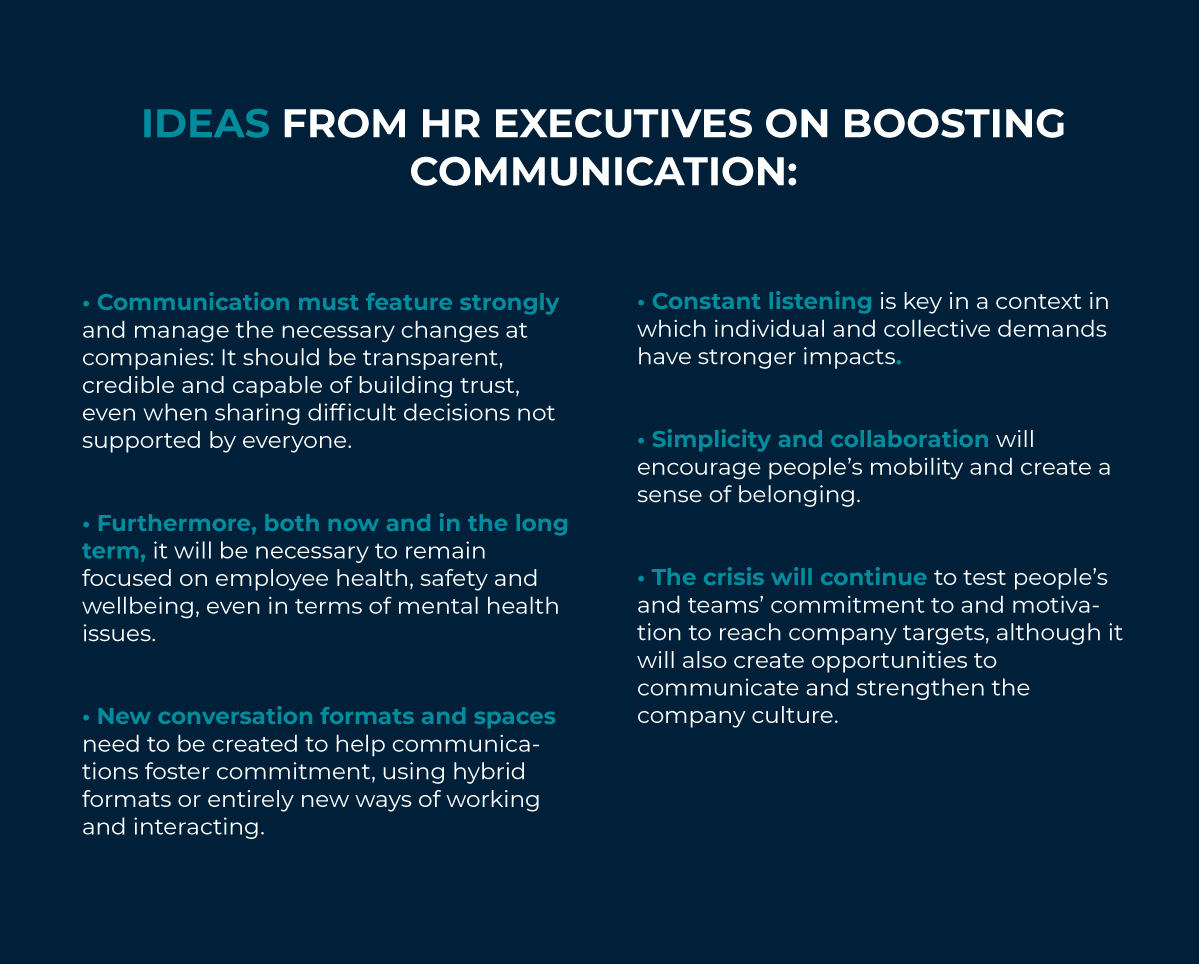As governments and health authorities juggle decisions on how to ease social lockdown measures, companies are either returning to their old pre-crisis ways of doing things or anticipating the steps they will need to take in order to resume business in this new normal, in which we have yet to find a vaccine or an effective treatment for COVID-19.
Health and safety in the corporate environment remain at the top of the priority list, although many other issues are also being discussed, including the drop in revenue and investment, a reevaluation of structural needs at companies, business model and business transformation, new risks and protocols to follow, restructuring processes, operational and management challenges, communications and involvement, among others.
In the current context, all these variables are redefining how companies tackle the crisis stemming from this pandemic. This will, in many cases, lead to a permanent transformation of working patterns. In July, LLYC conducted a survey of 24 Human Resources, Talent or Personnel Management directors working at large companies operating in the Brazilian infrastructure, energy, technology, health and pharmaceutical sectors, as well as other financial and professional services areas. This study revealed some interesting, internationally relevant issues regarding the challenges posed by promoting real talent involvement at this crucial time for companies.
Amid this environment of uncertainty, changing mentalities and questions surrounding the new normal, companies are dealing with these critical decisions. This has become a genuine turning point, one in which they must now manage scenarios that nobody has dared to precisely define in absolute terms.
Few companies are certain about returning to their old business models and structures. It may be necessary (perhaps even welcome) to make certain changes in a context in which everyone is looking to recover revenue, adjust spending and reinvent their business to boost sustainability. At the dawn of this new normal, the main challenges lie in returning to old operating models, adopting suitable health and safety protocols, mental health and work-life balance, the role of executives, maintaining individual and group commitment, taking a people-focused approach and strengthening the organizational culture.
“Communication, which is playing a strategic role in all the challenges at this crucial time, represents one of the greatest difficulties that companies need to overcome. Businesses must also recognize that technology, which was already essential, has risen to a whole new level of priority”


For almost the entire five months in which we have seen the pandemic get worse and worse, companies of all sizes and in all sectors have had to tackle numerous obstacles. We have witnessed increased restrictions on economic activities and added, stricter social lockdown policies put in place by authorities, followed by a tentative easing of those measures and emerging expectations about a new normal. The main difficulties for businesses have included a drop in revenue and falling investments in companies, as well as the need for a physical presence in those activities considered “essential” and the corresponding health and safety risks for employees and customers alike.
Communication difficulties represent the third most significant obstacle, although it scored higher among management and senior executives than it did among the various teams and departments. Issues such as home offices, working from home, the need to adapt technologies and systems, wage cuts and redundancies, the impacts of which have already been dealt with or will form part of new long-term scenarios, are now less significant at this stage of the crisis.
Given the increased strategic importance of internal communications for companies, many had already started to develop structured programs in this regard. However, the COVID-19 pandemic has certainly boosted the need to maintain and strengthen connections between people and teams, resulting in increased activity, information and participatory actions that did not always depend on investing any significant financial resources.
Internal communications will continue to play an essential role in the new changes ahead, although from a talent and human resources management perspective, the expectation is that it will need to change in terms of format, content and approach in order to continue contributing effectively. The real employee health and safety concerns, insecurities and risks will need to become top priority. Companies must adopt strict protocols and procedures to encourage clear, objective and regular communications that respond to employees’ both emotional and practical wishes, thereby enabling everyone to feel as though they are a part of the collective commitments being made.
Following several months of too many videoconferences and live broadcasts, all aimed at replacing the need for face-to-face interaction and a collective desire to create a feeling of strong commitment and productivity, there is an urgent need for these formats to be reinvented. Technology has simplified internal communications, and this trend will only increase. However, it will be necessary to create new tools, conversation spaces and mechanisms capable of meeting relationship needs, even in hybrid formats. These must also cater to a rotating set of employees working on-site, a preventative measure to increase physical distancing.
Rather than focusing on the channels, content or events being organized, the focus must be placed on people. In the opinion of HR managers, personnel will need support for their mental health, work-life balance and other personal issues that should be examined according to individual decisions and points of view. There is growing agreement that companies’ and executives’ main focuses should be on the wellbeing of their employees, given that this will have a direct impact on motivation, productivity and results. Many even take this a step further, believing this focus on wellbeing and people will be maintained as the pandemic develops, perhaps even with increased control.
“The most successful internal commitment strategies during the crisis will be based on responding to collective and individual demands using a people-focused approach, and they will help consolidate a solid and authentic corporate culture”

If we consider a long-term outlook, it is important to highlight the impacts that go beyond being able to adapt to new business models, maintain an ability to react to and overcome adversity and resume business in the new or old normal. Between the arrival of this pandemic and the search for a way out of the crisis, the experiences ahead of us will need internal communications that are strong enough to help maintain, strengthen and spread our organizational culture within the new, uncertain and unknown context facing us all. Concerns exist around any new employees who join our company during the pandemic, the importance of executive communications about new ways of working, reduced interactions and in-person experiences and the loss of value in both formal or corporate situations and informal or affective situations.
“The challenges we currently face will involve maintaining close team bonds, improving relations between leaders and employees, understanding how best to focus involvement from departments and, finally, gathering the fruits of a solid and authentic corporate culture,” summarized one of the study participants. Amid so much uncertainty, the crisis also seems to offer the promise of a positioning opportunity for companies capable of swiftly adapting to adversity and dealing with the negative and rapid impacts of resuming business, all while implementing effective strategic communications capable of building trust over and above commitment.




